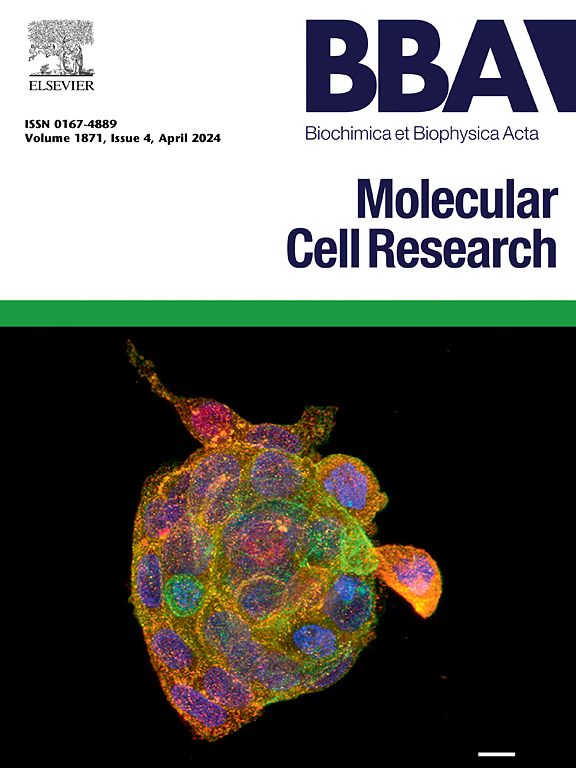组蛋白去乙酰化酶11调节应激颗粒形成,促进动脉粥样硬化中内皮向间质转化。
IF 3.7
2区 生物学
Q1 BIOCHEMISTRY & MOLECULAR BIOLOGY
Biochimica et biophysica acta. Molecular cell research
Pub Date : 2025-07-19
DOI:10.1016/j.bbamcr.2025.120026
引用次数: 0
摘要
组蛋白去乙酰化酶11 (HDAC11)是IV类HDAC家族中唯一的成员,与心血管疾病(cvd)有关。应激颗粒(Stress particle, SG)是由各种应激条件诱导的非膜性细胞质病灶,也是心血管疾病的重要发病机制。然而,在动脉粥样硬化过程中,HDAC11在SG形成中的调节作用及其机制尚不清楚。因此,我们旨在研究HDAC11对H2O2诱导的HFD和HUVECs对ApoE-/-小鼠SG的影响。首先,我们通过Western blotting、Real-time PCR和免疫荧光染色分析发现,经HFD喂养12w的ApoE-/-小鼠主动脉中SG核心蛋白G3BP1/2和HDAC11的表达水平升高。此外,在ApoE-/-小鼠的主动脉中发生了内皮到间质转化(EndMT)。然后,体外实验表明,H2O2处理HUVECs可导致SG形成、HDAC11上调和EndMT的发生。此外,siRNA敲低HDAC11可显著减弱H2O2诱导的HUVECs中SG的形成和EndMT的激活。HDAC11的沉默抑制了h2o2诱导的HUVECs中EndMT的激活,这可能是由于G3BP1/2乙酰化降低,从而损害了SG的形成。进一步的研究发现,抑制SG的形成促进内皮细胞标志物的表达降低,但降低间充质细胞标志物的水平。综上所述,这些发现表明HDAC11可能调节SG的形成以促进动脉粥样硬化中的EndMT,靶向SG可能是解决动脉粥样硬化潜在机制的一种新的治疗策略。本文章由计算机程序翻译,如有差异,请以英文原文为准。

Histone deacetylase 11 regulates stress granule formation to promote endothelial-to-mesenchymal transition in atherosclerosis
Histone deacetylase 11 (HDAC11) is the only member of the class IV HDAC family and is involved in cardiovascular diseases (CVDs). Stress granule (SG) is non-membranous cytoplasmic foci induced by various stress conditions, and also has emerged as a key player for CVDs. However, the regulatory role of HDAC11 in SG formation and underlying mechanism during atherosclerosis remain elusive. Therefore, we aimed to investigate the effect of HDAC11 on SG in ApoE−/− mice fed with a HFD and HUVECs induced by H2O2. Firstly, we found that the expression levels of SG core proteins G3BP1/2 and HDAC11 were increased in the aorta of ApoE−/− mice fed with a HFD for 12w via analyses of Western blotting, Real-time PCR and immunofluorescence staining. In addition, endothelial-to-mesenchymal transition (EndMT) was occurred in the aorta of ApoE−/− mice. Then, in vitro experiments demonstrated that treatment of HUVECs with H2O2 resulted in SG formation, HDAC11 upregulation, and EndMT occurrence. Furthermore, knockdown of HDAC11 by siRNA significantly attenuated SG formation and EndMT activation in HUVECs induced by H2O2. Silencing of HDAC11 suppressed H2O2-induced EndMT activation in HUVECs, which may be attributed to increased acetylation of G3BP1/2 and the consequent impairment of SG formation. Further studies found that suppression of SG formation not only facilitated the expression of endothelial markers, but also decreased the levels of mesenchymal cell markers. Taken together, these findings identified that HDAC11 may regulate SG formation to promote EndMT in atherosclerosis, targeting SG could represent a novel therapeutic strategy for addressing the underlying mechanisms of atherosclerosis.
求助全文
通过发布文献求助,成功后即可免费获取论文全文。
去求助
来源期刊
CiteScore
10.00
自引率
2.00%
发文量
151
审稿时长
44 days
期刊介绍:
BBA Molecular Cell Research focuses on understanding the mechanisms of cellular processes at the molecular level. These include aspects of cellular signaling, signal transduction, cell cycle, apoptosis, intracellular trafficking, secretory and endocytic pathways, biogenesis of cell organelles, cytoskeletal structures, cellular interactions, cell/tissue differentiation and cellular enzymology. Also included are studies at the interface between Cell Biology and Biophysics which apply for example novel imaging methods for characterizing cellular processes.

 求助内容:
求助内容: 应助结果提醒方式:
应助结果提醒方式:


